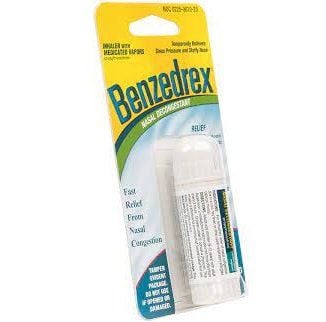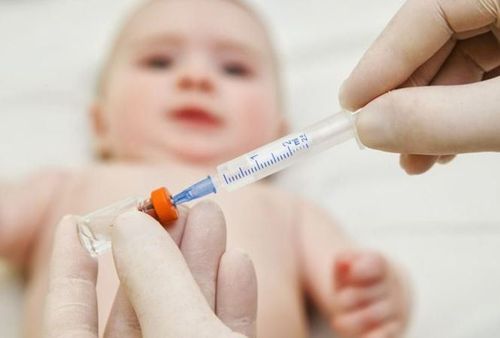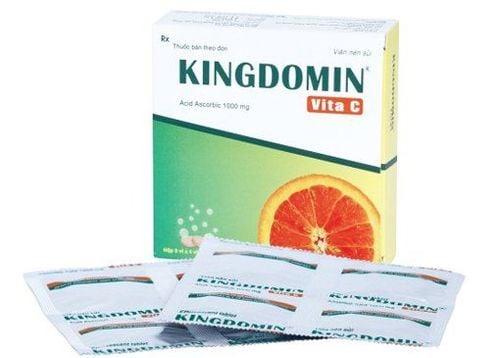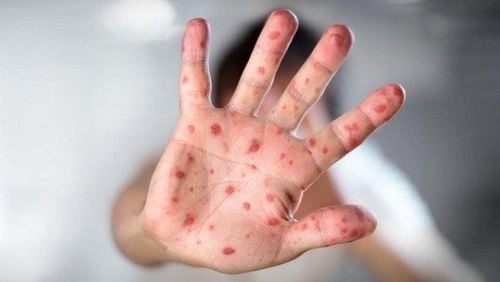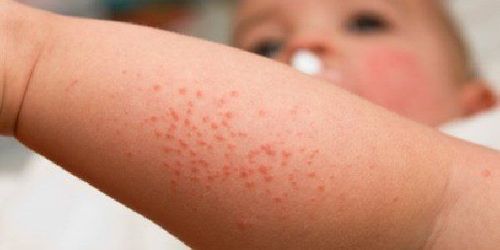This is an automatically translated article.
In many cases, parents do not distinguish between typhus and measles, leading to unfortunate mistakes in the process of caring for sick children. While typhus is fairly benign, measles carries the risk of serious complications.1. Causes of disease
1.1 Typhus The most common cause of typhus in children is a common viral infection, accounting for 70-80% of cases. Most of them are respiratory viruses, such as rubella virus. Typhus is a fairly benign disease and is not dangerous.1.2. Measles Measles is an acute infectious disease caused by a virus of the genus Morbillivirus of the family Paramyxoviridae. This virus is highly contagious, so it is easily transmitted from an infected person to a healthy person through direct inhalation, specifically the saliva that the patient releases when coughing or sneezing. The disease is easy to cause epidemics, especially in places where many children are concentrated. Although measles typhus is quite benign at first, if it progresses to the stage of serious complications, it can be life-threatening.
Trắc nghiệm: Bạn có phân biệt được chính xác cảm lạnh và cúm mùa?
Cảm cúm và cảm lạnh là hai khái niệm mà chúng ta thường đánh đồng nó giống nhau, không phân biệt rõ ràng. Dưới đây là một số câu hỏi trắc nghiệm, giúp bạn có thêm những kiến thức phân biệt cảm lạnh và cảm cúm. Từ đó, có những biện pháp điều trị bệnh phù hợp.2. Symptoms of the disease
2.1. The common point between measles and typhus According to doctors, the two diseases typhus and measles are similar in the incubation period. Common symptoms seen at this stage are:Mild fever or high fever 38 - 39 degrees Celsius; Feeling tired, lethargic; Headache, muscle aches; Anorexia, breastfeeding; Some children may experience vomiting or diarrhea. 2.2. Typhus After the fever subsides, the child will enter the rash phase that lasts from 1 to 5 days. Answering the question of how to distinguish typhus, doctors say that typical features of common typhus are:
Red and bright red spots; Smooth, less rough rash on the skin surface; Rash rash all over the body; After diving, there are usually no scars or bruises. 2.2. Measles So how is typhus different from measles? Measles disease progresses through 4 specific stages, including incubation, onset, measles rash, and recovery. In particular, measles rash has the following typical signs:
The rash appears in sequence: Starting behind the ears, then spreading to the face, gradually down to the chest, abdomen and covered all over the body; Papular rash, raised on the skin surface; Sometimes causing itching, discomfort for the patient; When diving, it will leave bruises, also known as "tiger stripes". More specifically, pediatric patients infected with typhus measles often have one of three distinguishing symptoms: Runny nose; Cough; Red eyes.

Sốt là dấu hiệu chung của sốt phát ban và sởi
3. Complications of typhus and measles
3.1. Typhus What is the difference between typhus and measles? Because typhus is caused by a group of common viruses, most illnesses are benign. For children with typhus, the disease will go away on its own after 5-7 days if the child receives:Proper medical care; Reasonable diet; Maintain body hygiene. Typhus also does not leave any dangerous complications for children.
3.2. Measles Children are the most commonly infected with measles typhus. This disease is considered dangerous because of the risk of superinfection and severe complications such as:
Diarrhea; Malnutrition Middle ear infections; Mouth ulcers Corneal ulcers; Pneumonia and bronchiolitis; Laryngitis and trachea; Encephalitis; Sometimes leads to death. While complications of measles are caused by the measles virus, most deaths stem from the severe and unpredictable course of measles superinfection.
4. Caring for a child with measles
4.1. Care at home For mild cases of measles, the child does not need to be hospitalized, instead the doctor will guide parents to treat at home. Specifically:Let the child rest in an isolated room to avoid cold winds; Take antipyretic drugs when fever is high; Use soft foods to protect the digestive tract; Regularly wear masks, limit direct contact; Supplement adequate nutrients to improve resistance; Fortified with vitamin A to support children's eyes; Only use drugs as prescribed by the doctor, especially avoid overusing antibiotics or trusting folk remedies; Keep the hospital room clean and well ventilated, no need to abstain from bathing or wind. 4.2. Monitoring at the hospital During home care, parents need to regularly monitor the child's temperature and symptoms. The child should be taken to the hospital for immediate treatment if:
Continuous high fever; Coughing a lot and having trouble breathing; Dehydration diarrhea; The measles rash is gone but still has a fever; Ears, lungs, digestive tract, eyes, ... have signs of complications.
5. Measles prevention

Biện pháp tốt nhất để phòng bệnh sởi là tiêm chủng ngừa vaccine sởi
1st dose: When the child is 9 months old; The second dose is repeated: When the child is 18 months old. Parents should note that both vaccines must be fully vaccinated to ensure 99% disease prevention. If only vaccinated with a single dose of vaccine, the ability to prevent disease is reduced to 90% and the child's body cannot create sustainable immunity. For children who have passed the vaccination schedule but still have not been fully vaccinated, along with not being infected with measles, parents need to take their children to a medical facility for vaccination advice.
5.2. In addition, parents can consult and choose to vaccinate their children with the 3-in-1 MMR vaccine - preventing 3 measles, mumps and rubella. Time for injections is as follows:
1st dose: When the child is 12 months old; 2nd dose booster: Injection between 4-6 years of age. Women of reproductive age and planning to have children should also receive the prenatal MMR vaccine to prevent disease for the mother as well as the fetus. In this case, only one dose is required, but it must be noted that at least 3 months after vaccination to get pregnant.
Properly recognizing how typhus differs from measles is the basis for proper pediatric care. By doing so, parents can help limit the risk of serious complications from measles, as well as keep their children healthy and heal faster.
Please dial HOTLINE for more information or register for an appointment HERE. Download MyVinmec app to make appointments faster and to manage your bookings easily.




